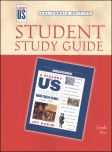We use cookies to make your experience better. To comply with the new e-Privacy directive, we need to ask for your consent to set the cookies. Learn more.
These guides are specifically for the 5th grade level. They are somewhat simplified versions of the study guides listed for grades 7-9, but still contain chapter lessons. In one or two spots, chapters from the corresponding books have been skipped or combined into a single lesson (the exception is in #008070 where only a selection of half the chapters from throughout book 4 and the first 12 chapters of books 5 are covered). A similar variety of activities and projects can be found throughout these guides. Student study guides for volumes 1 and 2 are California editions. California editions are similar in content and format to the non-California editions but have been developed specifically to meet the history/social science standards set forth by the state of California. ~ Zach




